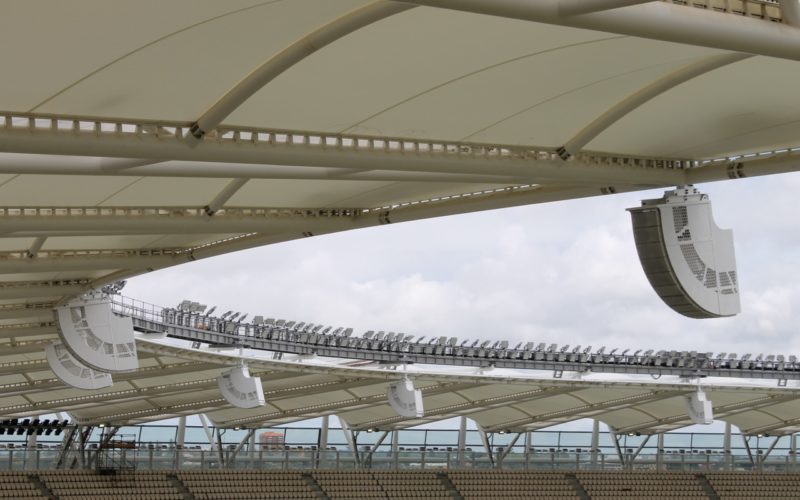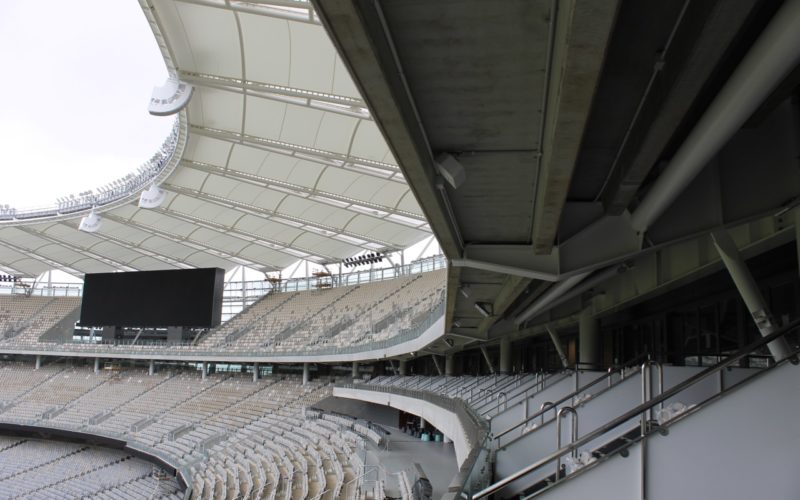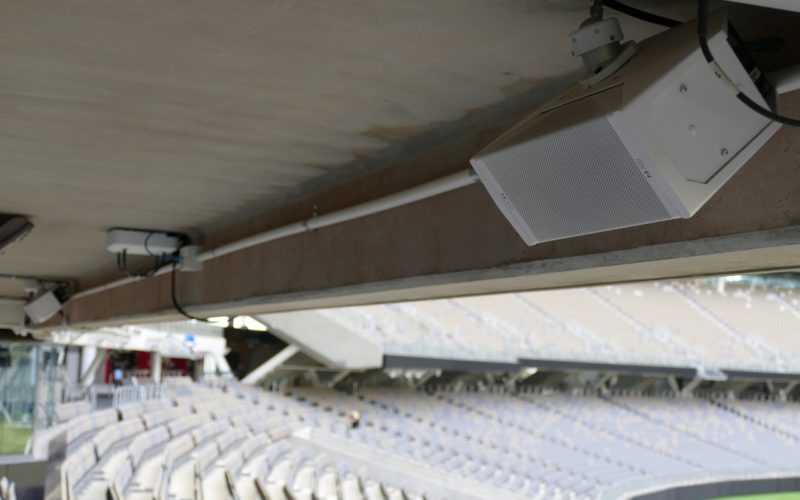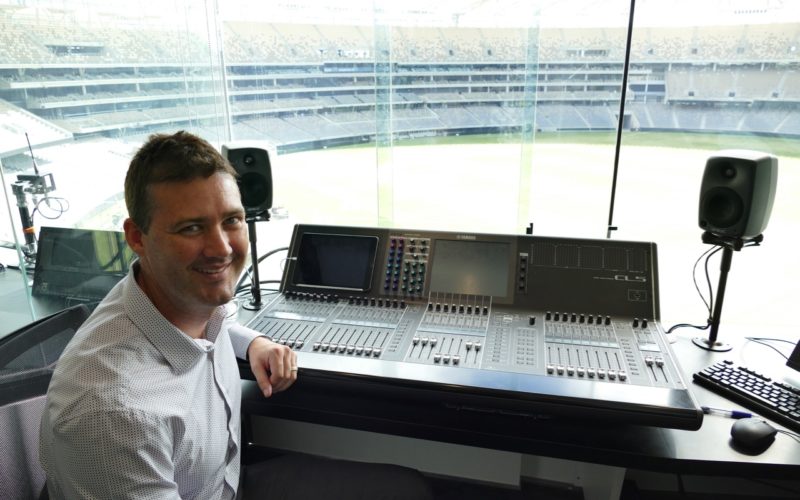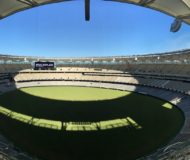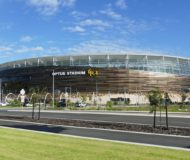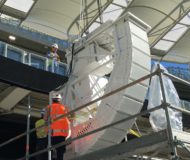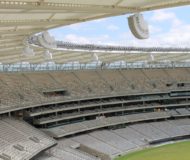Nearly 500 NEXO loudspeaker cabinets, line array and point-source, have been installed in the prestigious Optus Stadium in Perth, Western Australia, in a state-of-the-art AV system, delivered by Australia’s number one AV systems integrator, Rutledge AV. A 3-year design process included extensive evaluation of loudspeaker systems, with Group Technologies finally winning the contract with its NEXO solution.
The Optus Stadium is ranked as the third largest in Australia; home to two Australian League (AFL) teams, the venue hosts numerous international events in different sports, as well as high-profile live concerts. With over 1000 permanent loudspeakers in place throughout the stadium, controlled with a digital management system, it is considered the largest sound system in the country.
Rutledge AV was challenged to create a PA system that would deliver an ambitious 0.6 STi or above for the entire stadium seating area, referred to as the Main Bowl PA. Additionally, a nominal SPL of 102dB (±3dB) for all the 60,000-seated visitors was stipulated.
Based on three main criteria – capability, price and performance – Rutledge AV set about evaluating five loudspeaker systems. “Networking abilities, service support and rigging hardware capabilities were other paramount factors in making our decision,” says Elijah Steele, Rutledge Project Manager. “From the outset, NEXO was the clear winner for a variety of factors and, over the course of the project, the manufacturer proved themselves as great partners providing support whenever we required it. We’ve worked with their distributor, Group Technologies, many times before and knew we could fully rely on their support.”
Steele continues, “We favoured a line array solution, but knew we had to work within the existing design constraints. In addition to weight restrictions, there were limited locations for suspending the speakers owing to the fabric roof. Ultimately, we suspended arrays from the very tip of the roof structure.”
The project required wide advance consultation with structural engineers, to meet the requirements of health and safety. “Structurally, any installed materials have to be durable for the length of an infinite fatigue lifetime span for the main line array speakers. You also need to factor in 1-in-100-year extreme storm occurrences such as a major typhoon. Enduring such an environment close to the Indian Ocean and a desert with such a large structure is very challenging.”
Eighteen arrays, each combining 12x GEO S12 elements together with 3x LS18 18-inch sub bass cabinets, were installed to provide the bulk of the stadium’s SPL punch. Largely dictated by simulations using NEXO’s NS-1 software, the special GEO S1210 and S1230 modules provide long-throw capabilities to ensure even coverage down to the L1 seating areas. Vertical and horizontal control is further enhanced by the incorporation of the GEO S12’s Hyperbolic Reflective Wavesource, while a Directivity Phase Device extends coherency below normal LF-HF coupling limits. The presence of three additional LS18 sub bass units within each array extends the LF response to 32Hz at –6dB.
Having first sourced a specialised metalwork shop to create customised array casings for the 18x IP65-rated weatherised arrays, Steele then set about hiring professional subcontractors to conduct the works. Then there was the tricky obstacle of occupational health and safety to overcome, as the 18 hangs of line array were singled out as high-risk work.
From a temporary scaffold built above the seats, the line array sub-structures were individually created. A specialised super crane was placed onto the pitch to hoist the array – initially without its 15 cabinets – to each of the 18 equally spaced suspension points. In each case, a qualified sub-contractor on the roof structure created temporary mechanical attachments to suspend the sub- structure above the temporary scaffold. The GEO S12s and LS18 subs were then loaded, splayed, connected, tested and calibrated before attaching the side panels and raising them into their final position by the custom-built mobile dolly.
“The first array took some perfecting, but we soon got into a good rhythm of installing one array per day. We also integrated a customised mobile dolly that permanently lives on the roof gantry. It can then lower the line arrays from the catwalk to L1 for periodical servicing, cleaning and maintenance.”
To attain an STi of 0.6 for the under-balcony seating areas on L1, L3 and L4, a further 200x NEXO ID24 cabinets have been installed. Each delayed ID24 incorporates dual 4-inch drivers in a dipole arrangement, providing coverage in those spaces out of the full GEO S12 range. “These deceptively powerful boxes allowed us to fulfil the 100dB SPL handling in what we term the shadow areas, while their compact footprint provides discretion,” explains Steele.
Cabling conduits from each of the GEO S12 and LS18 arrays run to a number of L5 control room racks housing the NEXO NXAMP4x1 and NXAMP4x4 amplifier racks located within 85m. Equipped with processing presets, the NX amplifiers receive their signal from a Yamaha CL5 console with four MY8-ADDA96 cards located in a lower-level broadcast suite.
Operating over a digital Dante signal transport network, the integrated PA system is broadcast to all zones via the Q-LAN network. “In terms of monitoring and zone control, the Q-Sys platform had to fully integrate with the NEXO loudspeaker system, which ultimately required custom interfacing between two different protocols. Both manufacturers had to work together to create bespoke software scripts and commands to provide compatibility, so that the operator can monitor or mute the PA, for example.” Mobile configuration and monitoring has been added in the form of Yamaha’s Stage Mix app on an iOS touchscreen.
In addition to announcements and BGM, the Bowl PA also serves as a relay system during special events supplementing field sound systems. Furthermore, the Bowl PA can be isolated to individual tiers and seating areas, minimising acoustic reflections that are heard particularly during lower-capacity events. The lower tiers can be reduced or muted, allowing an even transition from the on-field system to the Bowl PA upper areas.
“Optus Stadium took us to a new level,” concludes Elijah Steele. “The line array structure alone was a massive undertaking, but then you have to add the cabling infrastructure, back of house premium venues and the broadcasting facilities to that. There were many challenges along the way but, ultimately, we pulled it off. From day one, the team we assembled was extremely committed and professional. The result is a multifunctional venue that can offer a high degree of flexibility depending on the scale of the event.
“Future-proofing played an important part in shaping the final schematics of the stadium, with some criteria demanding a design life to extend to 20 years. We had to really research what was out there on the market to ensure the technology was not in need of replacement several years from now. That’s why the fibre backbone is so important. Most hardware these days, such as the CL5 console and the Q-Sys Core processors, can be updated via their software and firmware, extending their use for many more years.”
With many thanks to Richard Lawn and Pro AVL magazine, for permission to reproduce some of their text and photographs. You can read their article via this link, and visit their awesome website on https://www.proavl-asia.com/
Further information:
Mark Ladewig
GROUP TECHNOLOGY
Tel: 0061 3 9354 9133













